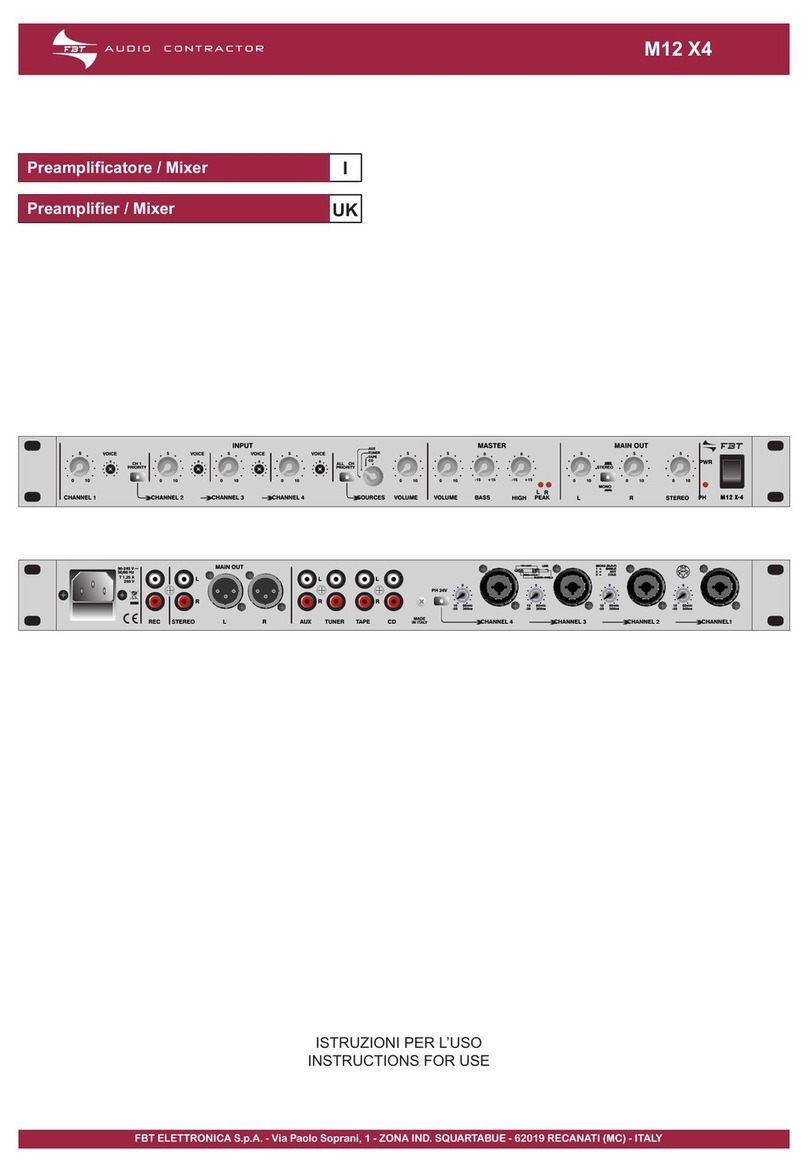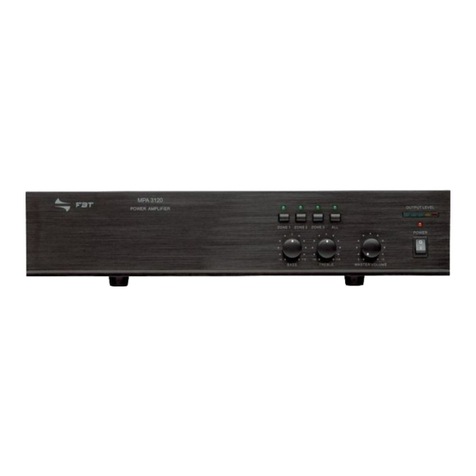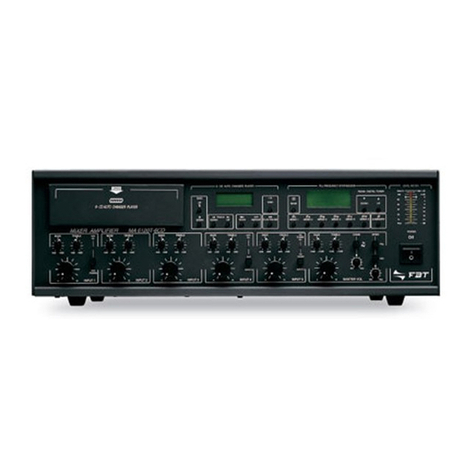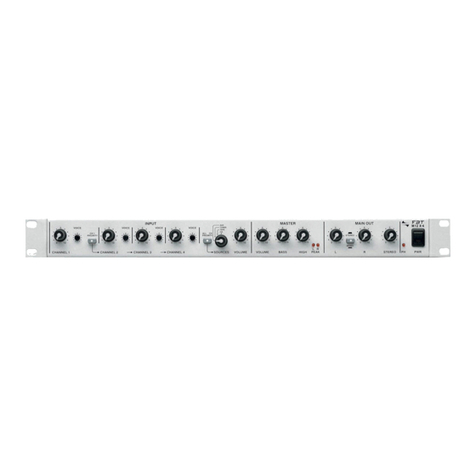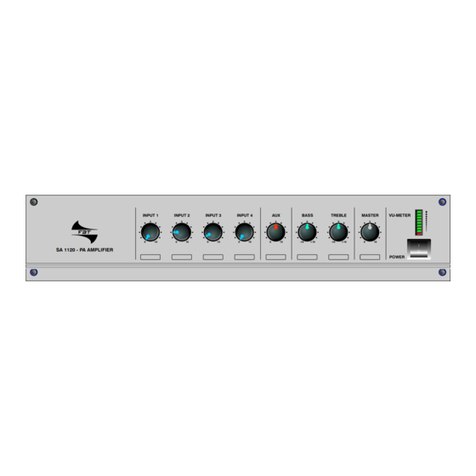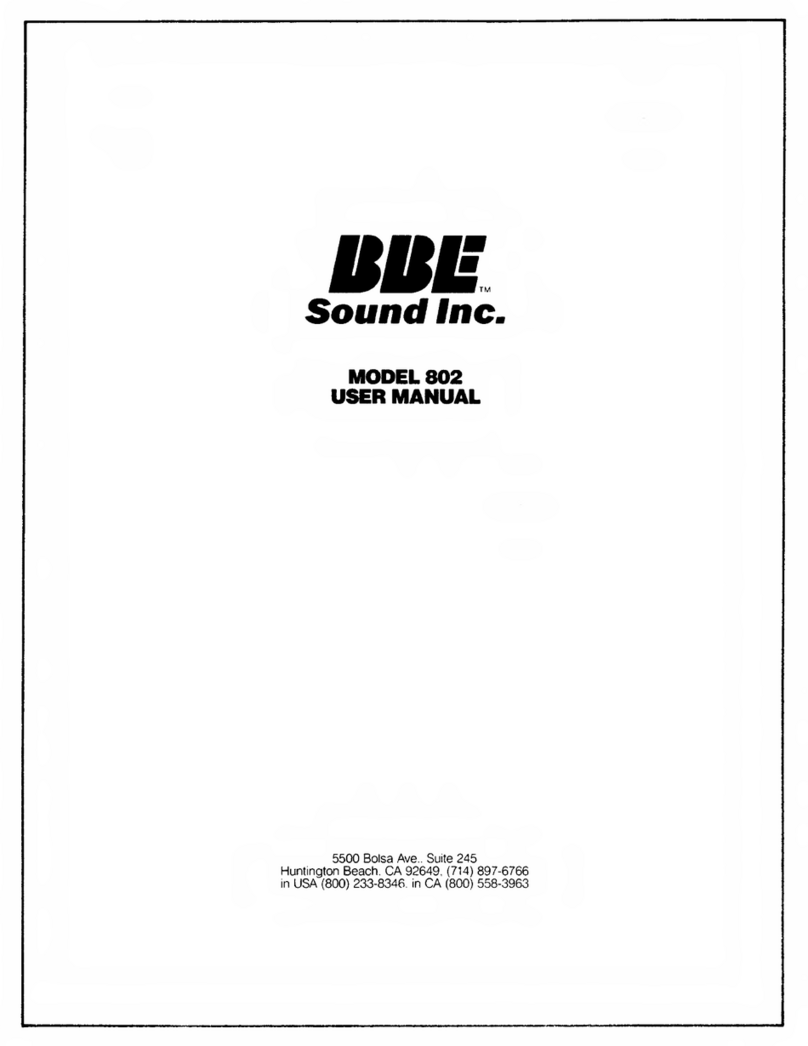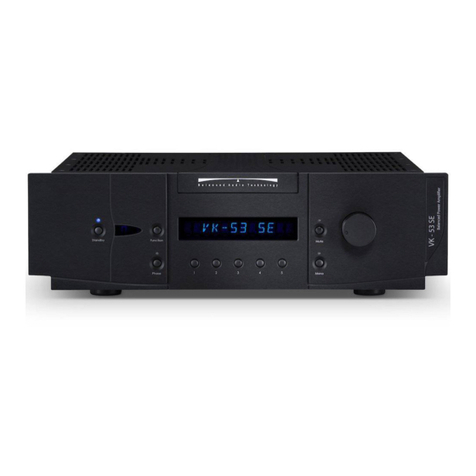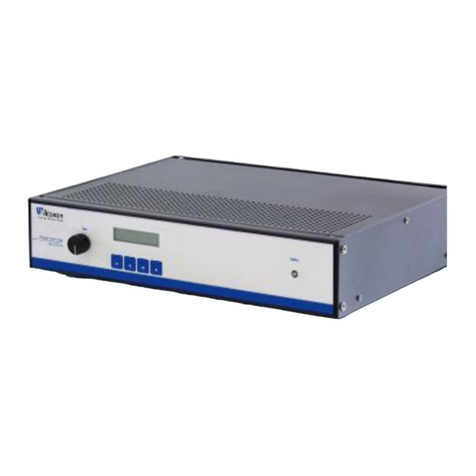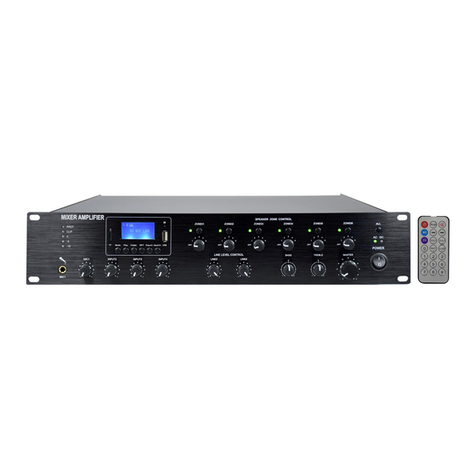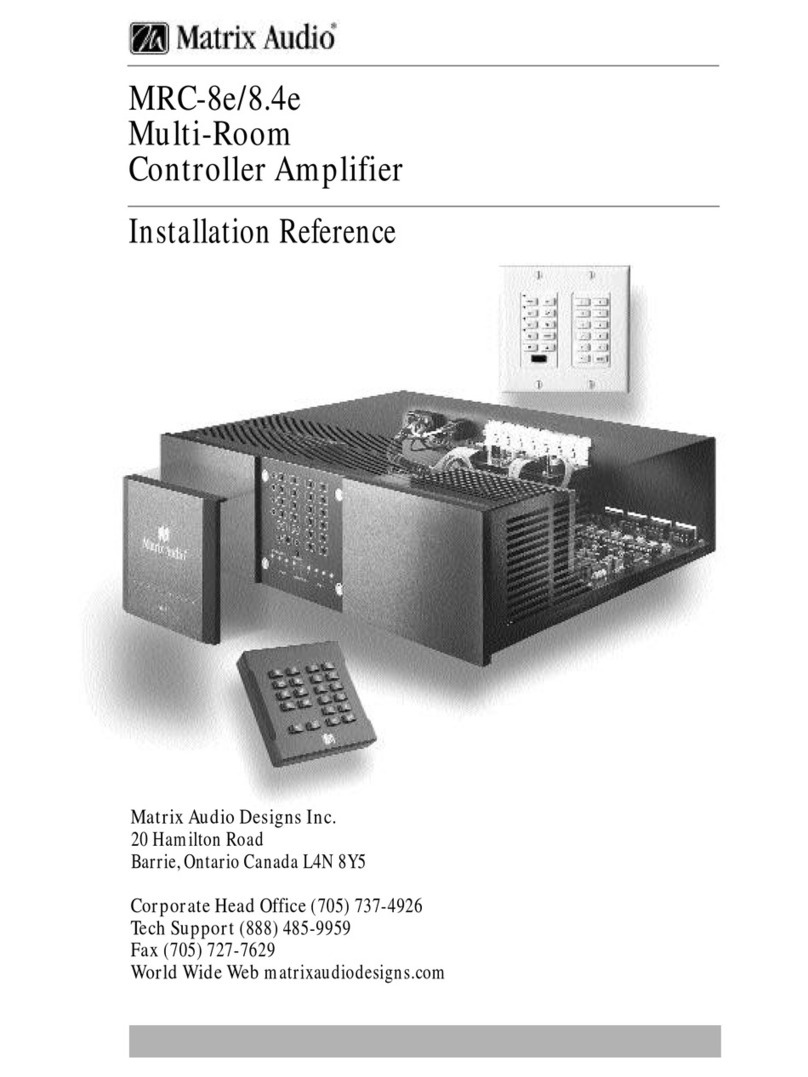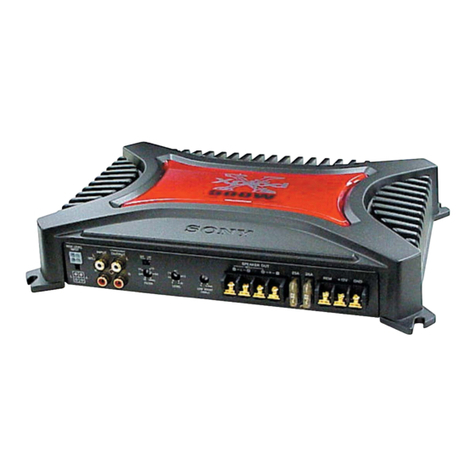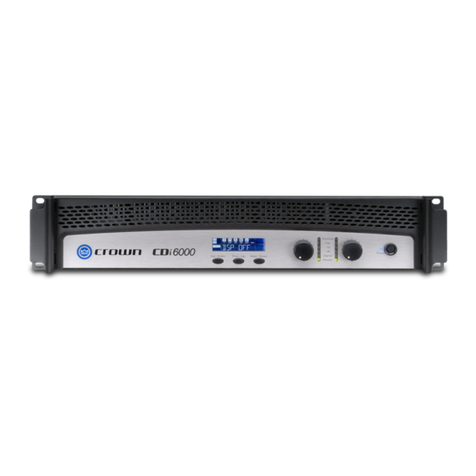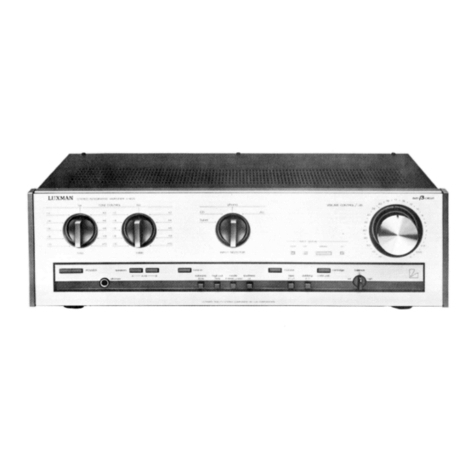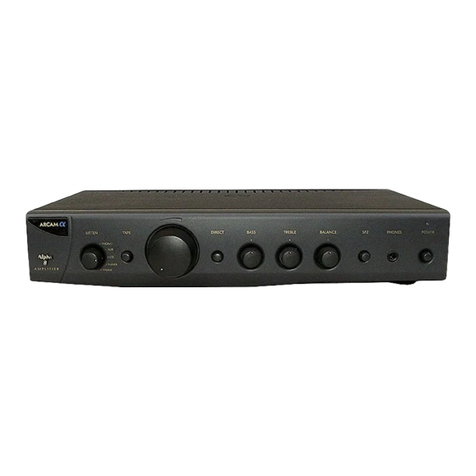Fbt MXA 1060 User manual

Amplifiers
Amplificateurs
Verstärker
MXA 1060
MXA 1120
FBT ELETTRONICA S.p.A. - Via Paolo Soprani, 1 - ZONA IND. SQUARTABUE - 62019 RECANATI (MC) - ITALY
ISTRUZIONI PER L’USO
INSTRUCTIONS FOR USE
MANUEL D’UTILISATION
GEBRAUCHSANLEITUNG
UK
Amplificatori I
D
F

i
IINDICE DEI CONTENUTI UK TABLE OF CONTENTS
1. AVVERTENZE 1
1.1 Alimentazione e messa a terra 1
1.2 Note di sicurezza 1
1.3 Installazione 1
2. DESCRIZIONE GENERALE 2
2.1 Pannello frontale 2
2.2 Pannello posteriore 2
3. CONNESSIONI 3
3.1 Criteri generali 3
3.2 Ingressi microfonici e priorità 3
3.3 Ingresso MIC.3/UNITS 3
3.4 Ingresso MIC.4/LINE 3
3.5 Filtro parola 4
3.6 Ingressi ausiliari 4
3.7 Ingresso telefonico 4
3.8 Precedenza microfonica e segnale di preavviso 4
3.9 Collegamento delle postazioni 5
3.10 Uscite di potenza 5
3.11 Uscita di linea 5
4. USO 6
4.1 Accensione 6
4.2 Controllo di volume principale 6
4.3 Correzione acustica 6
5. NOTE DI SERVIZIO 7
5.1 Sovraccarico e protezione 7
DATI TECNICI 7
1. WARNINGS 1
1.1 Power supply and earthing 1
1.2 Safety notes 1
1.3 Installation 1
2. GENERAL DESCRIPTION 2
2.1 Front panel 2
2.2 Rear panel 2
3. CONNECTIONS 3
3.1 General criteria 3
3.2 Microphone inputs and priority 3
3.3 MIC.3/UNITS input 3
3.4 MIC.4/LINE input 3
3.5 Speech filter 4
3.6 Auxiliary inputs 4
3.7 Telephone input 4
3.8 Microphone precedence and warning signal 4
3.9 Connecting the stations 5
3.10 Power outputs 5
3.11 Line output 5
4. USO 6
4.1 Start-up 6
4.2 Master volume control 6
4.3 Acoustic adjustment 6
5. SERVICE NOTES 7
5.1 Overload and protection 7
TECHNICAL DATA 7
1. PRECAUTIONS 9
1.1 Alimentation et mise à la terre 9
1.2 Conseils de securite 9
1.3 Installation 9
2. DESCRIPTION GENERALE 10
2.1 Panneau frontal 10
2.2 Panneau posterieur 10
3. CONNEXIONS 11
3.1 Critères generaux 11
3.2 Entrées microphoniques et priorité 11
3.3 Entrée MIC.3/UNITS 11
3.4 Entrée MIC.4/LINE 11
3.5 Filtre voix 12
3.6 Entrées auxiliaires 12
3.7 Entrée téléphonique 12
3.8 Priorité microphonique et signal de préavis 12
3.9 Branchement des postes 13
3.10 Sorties de puissance 13
3.11 Sortie de ligne 13
4. UTILISATION 14
4.1 Mise en marche 14
4.2 Contrôle de volume principal 14
4.3 Correction acoustique 14
5. NOTICES DE SERVICE 15
5.1 Surcharge et protection 15
DONNEES TECHNIQUES 16
FSOMMAIRE
1. HINWEISE 9
1.1 Einspeisung und Erdung 9
1.2 Sicherheitsanweisungen 9
1.3 Installation 9
2. ALLGEMEINE BESCHREIBUNG 10
2.1 Frontpaneel 10
2.2 Rückpaneel 10
3. ANSCHLÜSSE 11
3.1 Allgemeine Hinweise 11
3.2 Mikrofoneingänge und Vorrang 11
3.3 Eingang MIC.3/UNITS 11
3.4 Eingang MIC.4/LINE 11
3.5 Sprachfilter 12
3.6 Hilfseingänge 12
3.7 Telefoneingang 12
3.8 Mikrofonvorrang und Ankündigungssignal 12
3.9 Anschluss der Sprechstellen 13
3.10 Leistungausgänge 13
3.11 Leitungsausgang 13
4. GEBRAÜCH 14
4.1 Einschalten 14
4.2 Steuerung der Hauptlautstärke 14
4.3 Tonkorrektur 14
5. SERVICEANWEISUNGEN 15
5.1 Überlastung und Schutz 15
TECHNISCHE EIGENSCHAFTEN 16
DINHALTSANGABE

1
IUK
1.1 ALIMENTAZIONE E MESSA A TERRA
Questi apparecchi sono predisposti per il funzionamento con tensione
di rete a 230 V ± 10% 50/60 Hz. È possibile utilizzare l’apparecchio
anche con una tensione di rete di 120 V ± 10% 50/60 Hz; a tal scopo
è necessario portare il selettore (26) posto sul pannello posteriore in
posizione “120 V”. Gli amplificatori della Serie MXA 1000 possono
anche essere alimentati con una sorgente esterna di corrente
continua con tensione di 24 V che deve essere applicata, rispettando
le polarità, ai relativi terminali della morsettiera (11). In accordo con
le normative di sicurezza, l’interruttore di accensione (8) agisce solo
sulla tensione di rete. In dotazione all’apparecchio é fornito un cavo
di alimentazione con filo di terra; il terminale di terra della spina di
rete non deve essere rimosso in alcun caso. Collegare la spina di
rete (25) dell’apparecchio alla rete elettrica utilizzando l’apposito
cavo fornito in dotazione; assicurarsi che la presa di corrente sia
dotata di collegamento di terra a norma di legge. L’apparecchio è
protetto da due fusibili (vedi par. 5.1, pag. 7).
1.1 POWER SUPPLY AND EARTHING
This equipment is designed for use with a mains voltage of
230 V ± 10% 50/60 Hz. It is also possible to use the equipment with
a mains voltage of 120 V ± 10% 50/60 Hz; to do this it is necessary
to position the rear-panel selector switch (26) on “120 V”.
The amplifiers of the MXA 1000 Series can also be powered by
means of an external DC power supply with a voltage of 24V, which
has to be applied to the appropriate terminals on the terminal strip
(11) paying attention to the correct polarity. As required under safety
regulations, the ON/OFF switch (8) only controls the mains voltage.
The equipment is supplied with its own power-supply cable, which
is equipped with an earthing wire. The earth terminal of the mains
plug should never be removed under any circumstances. Connect
the mains plug (25) of the equipment to the power mains using
the cable included in the supply. Make sure that the power outlet
is equipped with a connection to earth in accordance with the law.
The equipment is protected by two fuses (see point 5.1, page 7).
AVVERTENZE WARNINGS
1.3 INSTALLAZIONE
Gli apparecchi MXA 1060 e MXA 1120 sono predisposti per il
montaggio in mobile rack 19” tramite l’uso di appositi accessori
opzionali. Si consiglia di interporre un pannello di aerazione tra un
apparecchio e l’altro.
1.3 INSTALLATION
The MXA 1060 and MXA 1120 equipments are designed for
mounting in 19” rack cabinets using appropriate optional accessories.
Positioning of an aeration panel between one item of equipment and
the next is recommended.
1.2 NOTE DI SICUREZZA
Durante il funzionamento dell’apparecchio è necessario assicurare
un’adeguata ventilazione. Evitare di racchiudere l’apparecchio in
un mobile privo di aerazione o di ostruire le fessure di ventilazione;
evitare inoltre di tenere l’apparecchio in prossimità di sorgenti di
calore. Si consiglia di interporre un pannello di aerazione tra un
apparecchio e l’altro. Ogni intervento all’interno dell’apparecchio,
quale la selezione di alcuni modi d’uso o la sostituzione di fusibili,
deve essere effettuato solo da personale specializzato: la rimozione
del coperchio rende accessibili parti con rischio di scosse elettriche.
Prima di rimuovere il coperchio accertarsi sempre che il cavo
di rete sia staccato. Nel caso di accidentale caduta di liquidi
sull’apparecchio, staccare immediatamente la spina di rete ed
interpellare il centro di assistenza FBT più vicino. La connessione
di telaio (10) consente di collegare altre apparecchiature per la
sola funzione di schermatura dei segnali a basso livello: questa
presa non deve essere utilizzata per il collegamento di sicurezza
del telaio alla terra.
1.2 SAFETY NOTES
While the equipment is working, it is necessary to provide adequate
ventilation. Do not close the equipment in a cabinet without ventilation
and do not obstruct the ventilation slits. Do not keep the equipment
in the vicinity of sources of heat. It is recommended that you place
a ventilation panel between one piece of equipment and the next.
Any activities inside the equipment, such as selecting some of the
operating modes, the installation of accessories or the replacement
of fuses, must be carried out by specialized personnel only: when the
cover is removed, parts liable to cause electric shocks are exposed.
Before removing the cover, always make sure that the power cord
has been disconnected. In the event that liquid is accidentally spilt
onto the apparatus, disconnect the mains plug immediately and
contact the nearest FBT Service Centre. The chassis connection
(10) may be used to connect other equipment only for the purpose
of shielding the low signals: this socket may not be used to connect
the chassis to earth for safety purposes.
Avvertenze per lo smaltimento del prodotto ai sensi
della Direttiva Europea 2002/96/EC Alla fine della sua
vita utile il prodotto non deve essere smaltito insieme
ai rifiuti urbani, ma deve essere consegnato presso gli
appositi centri di raccolta differenziata predisposti dalle
amministrazioni comunali, oppure presso i rivenditori
che forniscono questo servizio. Smaltire separatamente un rifiuto
elettrico e/o elettronico (RAEE) consente di evitare possibili
conseguenze negative per l’ambiente e per la salute derivanti da
un suo smaltimento inadeguato e permette di recuperare i materiali
di cui è composto al fine di ottenere un importante risparmio di
energia e di risorse. Su ciascun prodotto è riportato a questo scopo
il marchio del contenitore di spazzatura barrato.
Important information for correct disposal of the
product in accordance with EC Directive 2002/96/EC
This product must not be disposed of as urban waste at
the end of its working life. It must be taken to a special
waste collection centre licensed by the local authorities
or to a dealer providing this service. Separate disposal
of electric and/or electronic equipment (WEEE) will avoid possible
negative consequences for the environment and for health resulting
from inappropriate disposal, and will enable the constituent materials
to be recovered, with significant savings in energy and resources.
As a reminder of the need to dispose of this equipment separately,
the product is marked with a crossed-out wheeled dustbin.
Questo prodotto è conforme alle Direttive della
Comunità Europea sotto le quali lo stesso ricade.
This product is in keeping with the
relevant European Community Directives.

2
IUK
DESCRIZIONE GENERALE GENERAL DESCRIPTION
2.1 PANNELLO FRONTALE
1. Controlli di livello ingressi microfonici.
2. Controllo di livello ingresso microfonico/unità.
3. Controllo di livello ingresso microfonico/linea.
4. Controllo di livello ingressi ausiliari.
5. Selettore ingressi ausiliari.
6. Controlli di tono.
7. Controllo di volume generale.
8. Interruttore di rete.
9. Visualizzatore del livello d’uscita.
2.1 FRONT PANEL
1. Microphone inputs level control.
2. Microphone/unit input level control.
3. Microphone/line input level control.
4. Auxiliary inputs level control.
5. Auxiliary inputs selector.
6. Tone controls.
7. General volume control.
8. Mains switch.
9. Output level indicator.
2.2 PANNELLO POSTERIORE
10. Connessione telaio.
11. Morsettiera per alimentazione esterna in corrente continua.
12. Morsettiera uscita altoparlanti.
13. Uscita di linea.
14. Ingressi ausiliari.
15. Dip-switches impostazioni.
16. Ingresso MIC.4/LINE e relativo selettore
di modalità funzionamento.
17. Ingresso MIC.3/Unità MBT 1101.
18. Ingresso MIC.2.
19. Ingresso MIC.1 e relativa regolazione
della soglia d’attivazione precedenza VOX.
20. Regolazione di livello del segnale di preavviso.
21. Connessioni precedenza.
22. Ingresso emergenza da centralino telefonico.
23. Regolazione di livello ingresso telefonico.
24. Regolazione soglia d’attivazione precedenza ingresso
TEL./EMERG.
25. Spina di rete con fusibile incorporato.
26. Selettore della tensione di rete.
2.2 REAR PANEL
10. Frame connection.
11. Terminal strip for external DC power supply.
12. Loudspeakers output terminal strip.
13. Line output.
14. Auxiliary inputs.
15. Dip-switches for settings.
16. MIC.4/LINE input and relevant
operating mode selector switch.
17. MIC.3/MBT 1101 unit input.
18. MIC.2 input.
19. MIC.1 input and relevant VOX precedence
activation threshold adjustment.
20. Level control of the warning signal.
21. Precedence connections.
22. Emergency input from PABX.
23. Telephone input level adjustment.
24. TEL./EMERG. input precedence activation
threshold adjustment.
25. Mains plug with built-in fuse.
26. Mains voltage selector switch.

3
IUK
CONNESSIONI CONNECTIONS
3.1 CRITERI GENERALI
Peruncorrettofunzionamentodell’apparecchioè opportunoosservare
alcuni criteri di massima nell’esecuzione dei collegamenti:
• no
n posizionare cavi e microfoni sul mobile dell’apparecchio.
• evitare di stendere le linee di segnale parallele a quelle di rete;
osservare una distanza minima di 30/40 cm.
• posizionare le linee di ingresso e le linee di uscita distanti tra loro.
• posizionare i microfoni al di fuori dell’angolo di radiazione dei
diffusori sonori per evitare il fenomeno di reazione acustica (effetto
Larsen).
3.1 GENERAL CRITERIA
For proper unit operation, use the following instructions when making
the connections:
• Do not place cables or microphones on the unit cabinet;
• Do not lay signal lines parallel to power lines; ensure a minimum
distance of 30/40 cm between them;
• Keep input lines and the output lines far apart;
• Keep the microphones outside the operating span of the speakers
to avoid acoustic feedback (Larsen effect).
3.2 INGRESSI MICROFONICI E PRIORITÀ
Alle prese microfoniche è possibile collegare microfoni dinamici
bilanciati o sbilanciati dotati di spina XLR: i collegamenti a queste prese
sono riportati nella Fig. 3.2.1. Ogni ingresso microfonico dispone di
un proprio controllo di livello per dosare opportunamente l’ampiezza
dei vari segnali.
L’ingresso microfonico MIC.1 dispone, inoltre, della funzione di
precedenza automatica (VOX, vedi tabella 3.2.2). Il livello della soglia di
attivazione del circuito di precedenza automatica, regolato dal controllo
semifisso A.P.T. (19), è indipendente dalla posizione del controllo
MIC.1 (1). Le priorità e le funzioni del dip-switch PREC. SET (15) sono
illustrate nella tabella seguente:
3.3 INGRESSO MIC.3/UNITS
Alla presa XLR MIC.3 (17) è possibile collegare microfoni di tipo
dinamico e ad elettrete con alimentazione Phantom; i collegamenti a
queste prese sono riportati nella Fig. 3.2.1. In alternativa al microfono,
è possibile collegare alla presa IN UNITS una o più postazioni
microfoniche preamplificate MBT 1101. Per il collegamento di
questa postazione, è INDISPENSABILE utilizzare cavi schermati
di tipo STP CAT5.E. La regolazione del livello d’uscita è disponibile
al controllo frontale (2).
3.2 MICROPHONE INPUTS AND PRIORITY
It is possible to connect dynamic balanced/unbalanced microphones
with XLR plug to the microphone sockets: the connections to these
sockets are shown in Figure 3.2.1. Each microphone input has its
own level control for adjusting the amplitude of the various signals
suitably.
4.3 MIC.3/UNITS INPUT
It is possible to connect a dynamic or electret microphone with
a Phantom power supply to the MIC.3 XLR socket (17). The
connections to these sockets are shown in Fig. 3.2.1. As an
alternative to a microphone, it is also possible to connect one or more
MBT 1101 pre-amplified microphone stations, enabling messages
to be sent to one or more listening zones, to the IN UNITS socket.
It is ESSENTIAL to use shielded cables of the STP CAT5.E type
for connecting this station. The output level can be controlled
from the front panel (2).
The MIC.1 microphone input also has an automatic precedence function
(VOX, see table 3.2.2). The level of the threshold for activation of the
automatic precedence circuit - adjustable by A.P.T. control (19) - is
independent of the position of the MIC.1 control (1).
Priorities and functions of the PREC. SET dip-switch (15) are illustrated
below:
VOX TEL./EMERG. Ammutolisce tutti gli ingressi Mutes all inputs
VOX MIC.1
AMMUTOLISCE:
MIC.2
MIC.3/UNITS (se SW1 = ON)
MIC.4
CD
TAPE
MUTE:
MIC.2
MIC.3/UNITS (if SW1 = ON)
MIC.4
CD
TAPE
PRECEDENZA
PRECEDENCE
AMMUTOLISCE:
MIC.2 (if SW2 = ON)
MIC.3/UNITS (if SW3 = ON)
MIC.4 (se SW4 = ON)
CD
TAPE
MUTE:
MIC.2 (if SW2 = ON)
MIC.3/UNITS (if SW3 = ON)
MIC.4 (se SW4 = ON)
CD
TAPE
Tab. 3.2.2
3.4 INGRESSO MIC.4/LINE
La presa MIC.4/LINE (16) è configurabile in modo indipendente
come ingresso microfonico (con o senza alimentazione Phantom)
o come ingressi di linea.
3.4 MIC.4/LINE INPUT
The MIC.4/LINE socket (16) can be separately configured as
microphone input (with or without phantom power supply) or as
line input.
Fig. 3.2.1
Collegamento BILANCIATO
BALANCED connection
1Schermo / Shield
2 Segnale (lato caldo) / Signal (hot side)
3 Segnale (lato freddo) / Signal (cold side)
Collegamento SBILANCIATO
UNBALANCED connection
1Schermo e massa / Shield and GND
2 Segnale / Signal
3 Schermo e massa / Shield and GND

4
IUK
CONNESSIONI CONNECTIONS
3.5 FILTRO PAROLA
AgliingressiMIC.1-2-3eMIC.4/LINEèpossibileinserireunfiltroparola.
Per effettuare queste modifiche è necessario togliere il coperchio
dell’apparecchio: questa operazione deve essere svolta
ESCLUSIVAMENTE da personale specializzato. L’impostazione di
fabbrica prevede che il filtro sia disinserito: per inserirlo, posizionare
il jumper relativo all’ingresso/i interessato/i in posizione ON,
seguendo la tabella sottostante:
Jumper Ingresso
SW1 MIC.1
SW2 MIC.2
SW4 MIC.3/UNITS
SW5 MIC./LINE 4
3.6 INGRESSI AUSILIARI
Alle prese phono TAPE e CD (14) è possibile collegare
due sorgenti musicali ad alto livello (lettore di compact disc,
riproduttore a nastro). La doppia presa consente un veloce
collegamento della sorgente all’amplificatore tramite cavetto
stereo: la miscelazione dei due canali destro e sinistro
(L/R) è realizzata internamente. La selezione e la regolazione di
livello della sorgente avviene tramite l’apposito controllo PROGRAM
(4) posto sul pannello frontale dell’apparecchio. La sorgente
selezionata è soggetta all’ammutolimento sia per precedenza
automatica (VOX) degli ingressi TEL./EMERG. e MIC.1 che per
la chiusura del contatto PR (precedenza) o in caso di chiamata
proveniente da postazioni microfoniche MBT 1101.
3.7 INGRESSO TELEFONICO
Gli apparecchi sono predisposti per il collegamento ad un sistema
telefonico tramite la morsettiera TEL./EMERG. (22). Tale ingresso
è bilanciato a trasformatore, possiede un proprio controllo di livello -
LEV. (23) - ed è dotato di circuito VOX per la diffusione dei messaggi
con priorità più elevata rispetto a qualsiasi altro ingresso.
3.5 SPEECH FILTER
It is possible to install a speech filter on inputs MIC.1-2-3 and
MIC.4/LINE. To make these changes, the lid of the equipment must
be removed. This operation must be carried out by specialised
personnel ONLY. According to the factory setting, the filter is
de-activated. To activate it, place the jumper referred to the input
in question in the ON position, in accordance with the following
table:
Jumper Input
SW1 MIC.1
SW2 MIC.2
SW4 MIC.3/UNITS
SW5 MIC./LINE 4
3.6 AUXILIARY INPUTS
It is possible to connect two high-level sources of music (CD player,
tape recorder) to the TAPE and CD (14) phono sockets. Thanks to
the fact that there are two sockets, it is easy to connect the source
rapidly to the amplifier by means of a stereo cable: mixing of the two
channels (left and right - L/R) is carried out internally. The source is
selected by means of the selector PROGRAM (4) provided for this
purpose on the front panel of the equipment. The source selected
is subject to muting both due to automatic precedence (VOX) of
the TEL./EMERG. and MIC.1 inputs and following closure of the
PR (precedence) contact, or in case of a call from a MBT 1101
microphone station.
3.7 TELEPHONE INPUT
The equipment has provisions for connection to a telephone system
via the TEL./EMERG. terminal strip (22). This input is balanced by a
transformer, has its own level control - LEV. (23) – and is equipped
with a VOX circuit for broadcasting messages with a higher priority
than any other input.
La selezione della modalità è ottenuta tramite il relativo deviatore
a tre posizioni posti a lato della presa:
• in posizione MIC, si seleziona la sensibilità microfonica con
alimentazione phantom disattivata;
• in posizione PH, si seleziona la sensibilità microfonica attivando
l’alimentazione phantom (per microfoni elettrete 12/24V);
• in posizione LINE, si seleziona la sensibilità di linea.
I collegamenti a queste prese sono riportati nella Fig. 3.2.1.
La regolazione del livello d’uscita è disponibile al controllo frontale
(3).
The operating mode can be selected by means of the specific three-
position switch next to the socket:
• in the MIC position the sensitivity of the microphone with the
phantom power supply de-activated is selected;
• in the PH position the sensitivity of the microphone with
the phantom power supply activated (for 12/24V electret
microphones) is selected;
• in the LINE position the sensitivity of the line is selected.
The connections to these sockets are shown in Figure 3.2.1.
The output level can be controlled from the front panel (3).
TEL./EMERG.
HOT Ingresso (lato caldo)
COM Ingressi (lato freddo)
GND Massa e schermo
TEL./EMERG.
HOT Input (warm side)
COM Input (cold side)
GND GND and shield
Fig. 3.7.1
3.8 PRECEDENZA MICROFONICA E SEGNALE DI PREAVVISO
Chiudendo i contatti PR e +12V della morsettiera (21) o effettuando
una chiamata dalla postazione MBT 1101, viene generato un
segnale di preavviso a due toni (CHIME); è possibile modificare il
livello di questo segnale agendo sul relativo trimmer LEV. (20).
3.8 MICROPHONE PRECEDENCE AND WARNING SIGNAL
When the contacts PR and +12V of the terminal strip (21) are closed,
or when there’s an incoming call from a MBT 1101 microphone
station, a two-tone warning signal (CHIME) is generated. It is
possible to adjust the level of the warning signal by means of the
LEV. trimmer (20).

5
IUK
CONNESSIONI CONNECTIONS
3.9 COLLEGAMENTO DELLE POSTAZIONI
Agli amplificatori MXA 1060 e MXA 1120 possono essere collegate
in modo semplice e veloce le postazioni microfoniche MBT 1101.
Queste postazioni microfoniche sono caratterizzate entrambe da un
microfono elettrete. Per il collegamento di questi due modelli, è
INDISPENSABILE utilizzare dei cavi STP CAT5.E (schermati).
3.9 CONNECTING THE STATIONS
Connecting the MBT 1101 microphone stations to the MXA 1060
and MXA 1120 amplifiers is simple and rapidly achieved.
Both these pre-amplified microphone stations feature electret
microphones.To connect these two models, it is ESSENTIAL to
use STP CAT 5.E cables (shielded).
3.10 USCITE DI POTENZA
Leuscitedipotenzaperidiffusorisonodisponibilisullamorsettiera(12).
È possibile realizzare un impianto di diffusione sonora utilizzando
sia diffusori a bassa impedenza (fig. 3.10.1), sia diffusori dotati di
traslatore di linea (fig. 3.10.2).
Fig. 3.10.2Fig. 3.10.1
3.10 POWER OUTPUTS
The power outputs for the loudspeakers are available on the terminal
strip (12). It is possible to set up a sound-broadcasting system using
either low-impedance loudspeakers (fig. 3.10.1) or loudspeakers
equipped with a line transformer (fig. 3.10.2).
Fig. 3.9.1
Tab. 3.10.3
Uscita • Output MXA 1060 MXA 1120
8 W22 V 31 V
50 V 42 W20,8 W
70 V 82 W40,8 W
100 V 167 W83,3 W
In entrambi i casi il carico complessivo non deve essere tale da
sovraccaricare l’amplificatore: non applicare cioè diffusori o gruppi
di diffusori con impedenza più bassa di quella nominale della presa
alla quale sono collegati.
In both cases the overall load must not be such as to overload the
amplifier. This means that you must not apply loudspeakers or
groups of loudspeakers with an impedance lower than the rated
impedance of the socket to which they are connected.
Si raccomanda inoltre di porre particolare
attenzione al calcolo delle impedenze nel
caso si debbano realizzare impianti di
diffusione misti (a bassa impedenza e a
tensione costante).
In tabella 3.10.3 sono riportati i valori
nominali di tensione ed impedenza per le
diverse uscite.
It is also necessary to pay particular
attention to calculating the impedance
values if mixed broadcasting systems (low
impedance and constant voltage) are to
be set up.
Table 3.10.3 shows voltage and impedance
rated values for the various outputs.
3.11 USCITA DI LINEA
Alla presa di uscita LINE OUT (13) è disponibile il segnale di
pilotaggio della parte di potenza costituito dalla miscelazione delle
diverse sorgenti:tale segnale può essere utilizzato per il pilotaggio di
unità di potenza e/o inviato ad una piastra di registrazione.
3.11 LINE OUTPUT
The signal for driving the power part consisting of the mixing of the
various sources before the master volume control is available on
the LINE OUT output socket (13). This signal can be used to drive
power units and/or sent to a recording deck.

6
IUK
USO USE
4.1 ACCENSIONE
Prima di mettere in funzione l’apparecchio accertarsi di avere
realizzato tutte le connessioni necessarie al completamento
dell’impianto e di aver effettuato le impostazioni di funzionamento.
Portare l’interruttore di rete POWER (8) in posizione ON.
Se necessario, ritoccare i livelli delle sorgenti sonore per una
corretta equalizzazione dei segnali tramite i controlli di livello (1),
(2), (3) e (4).
4.2 CONTROLLO DI VOLUME PRINCIPALE
Il controllo di volume principale MASTER (7) regola il livello
complessivo del segnale d’uscita, derivato dalla miscelazione dei
vari segnali di ingresso.
4.3 CORREZIONE ACUSTICA
I controlli BASS e TREBLE (6) modificano la tonalità del segnale
d’uscita derivato dalla miscelazione dei vari segnali di ingresso.
• Controllo toni bassi (BASS)
Il controllo BASS regola le prestazioni dell’amplificatore alle basse
frequenze. La posizione di centro, indicata dallo “0”, fornisce una
risposta lineare; per avere una esaltazione delle frequenze basse
ruotare la manopola in senso ORARIO. Utilizzando diffusori
a tromba è opportuno tramite il comando BASS, attenuare le
frequenze basse; un eccessivo livello delle basse frequenze
potrebbe danneggiare la membrana del diffusore.
• Controllo toni acuti (TREBLE)
Il controllo TREBLE regola le prestazioni acustiche dell’amplificatore
alle alte frequenze. La posizione di centro, indicata dallo “0”, fornisce
una risposta di tipo lineare; per avere una esaltazione delle frequenze
alte ruotare la monopola in senso ORARIO. L’attenuazione dei toni
acuti è utlie per minimizzare un eccessivo livello di fruscio o per
rendere più dolci suoni particolarmente sibilanti.
4.1 START-UP
Before starting up the equipment, make sure that all the connections
required for completing the system have been made and that all
the settings for correct operation have been made.
Set the mains switch POWER (8) to the ON position.
If necessary, and adjust the levels of the sound sources for correct
equalisation of the signals by means of the level controls (1), (2),
(3) and (4).
4.2 MASTER VOLUME CONTROL
The MASTER volume control (7) adjusts the output signal overall
level as generated by mixing different input signals.
4.3 ACOUSTIC ADJUSTMENT
The BASS and TREBLE controls (6) adjust the output signal tone
generated by mixing the different input signals.
• Bass control (BASS)
The BASS control adjusts the amplifier performance at low
frequencies. The center position “0”. provides a linear response. To
emphasize low frequencies, turn the knob clockwise; to attenuate
them, turn the knob CLOCKWISE. When horn-type speakers
are used, low frequencies should be attenuated by means of the
BASS control. An excessive low frequency level could damage the
speaker diaphragm.
• Treble control (TREBLE)
The TREBLE control adjusts the amplifier performance at high
frequencies. The center position “0” provides a linear response.
To emphasize high frequencies, turn the knob clockwise; to
attenuate them, turn the knob CLOCKWISE. Attenuation of the
treble tones is useful for minimising and excessive level of rustling
or in order to soften hissing sounds.

7
IUK
NOTE DI SERVIZIO SERVICE NOTES
5.1 SOVRACCARICO E PROTEZIONE
Applicare un valore di impedenza di carico inferiore a quella
nominale significa richiedere all’apparecchio una potenza superiore
a quella erogabile con continuità. Questo potrebbe portare al
danneggiamento degli stadi finali di potenza e dei trasformatori di
alimentazione e di uscita. Per non incorrere in questi inconvenienti
gli amplificatori della Serie MXA 1000 sono abbondantemente
dotati di circuiti e dispositivi di protezione contro i sovraccarichi
ed i cortocircuiti:
• circuito limitatore di picco della corrente di uscita: il suo intervento
è istantaneo ed agisce tipicamente nel caso di sovraccarico.
• interruttore termico posto all’interno del trasformatore
d’alimentazione: interrompe l’alimentazione primaria nel
caso di eccessivo surriscaldamento del trasformatore. Il
ripristino è automatico, dopo una fase di raffreddamento del
trasformatore.
• circuito protezione sovraccarico: interviene bloccando il
pilotaggio dei finali quando si manifesta una condizione di
sovraccarico protratta nel tempo. Il suo intervento è segnalato
dalla spia luminosa OVL. (9).
• fusibile di rete - accessibile sulla presa rete (25): questo
dispositivo garantisce il blocco immediato del funzionamento
dell’amplificatore in caso di guasto interno dello stesso.
5.1 OVERLOAD AND PROTECTION
Applying a load impedance value lower than the rated loan means
that the equipment is required to supply power in excess of the
capacity that can be delivered with continuity. This could lead
to damage to the final power stages and of the power supply
and output transformers. In order not to incur these upsets, the
amplifiers of the MXA 1000 Series are equipped with a large
number of circuits and devices protecting them against overloads
and short circuits:
• circuit for limiting output current peaks: this is triggered
instantaneously and functions typically in the event of an
overload.
• Thermal switch inside the power-supply transformer. It cuts off
the primary power in the event of excessive overheating of the
transformer. It resets automatically once the transformer has
cooled down.
• circuit for protecting against overloads: this works by stopping
the final stages from being driven when a condition of overload
lasting in time occurs. Its operation is signalled by the OVL. (9)
signalling lamp.
•
mains fuses - accessible on the mains plug (25) - and on the internal
low-voltage power supply (accessible inside the equipment, on
the power supply circuit): these devices stop the amplifier working
immediately in case of internal failure inside it.

8
IUK
DATI TECNICI TECHNICAL DATA
MODELLO MXA 1060 MXA 1120 MODEL
Potenza di uscita nominale 60 W 120 W Rated power output
Uscite a tensione costante 50 - 70 - 100 V Constant voltage outputs
Uscite a bassa impedenza 8 WLow impedance outputs
Distorsione alla potenza nominale <1% Distorsion at rated power
Controllo toni Tones control
Toni gravi ±10 dB (100 Hz) Bass tones
Toni acuti ±10 dB (10 kHz) Treble tones
Ingresso MIC.1 MIC.1 input
Sensibilità/impedenza 0,9 mV / 900 WSensitivity/impedance
Rapporto segnale/disturbo ≥ 62 dB S/N Ratio
Risposta in frequenza 40 ÷ 20.000 Hz Frequency response
Alimentazione Phantom 17 V Phantom supply
Soglia d’attivazione VOX 5,4 mV VOX activation threshold
Ingresso MIC.2 MIC.2 input
Sensibilità/impedenza 0,9 mV / 900 WSensitivity/impedance
Rapporto segnale/disturbo > 62 dB S/N Ratio
Risposta in frequenza 40 ÷ 20.000 Hz Frequency response
Alimentazione Phantom 17 V Phantom supply
Ingresso MIC.3/UNITS MIC.3/UNITS input
Sensibilità/impedenza MIC: 0,9 mV / 900 W; UNITS: 290 mV / 700 kWSensitivity/impedance
Rapporto segnale/disturbo MIC.3: 62 dB ; UNITS: 65 dB S/N Ratio
Risposta in frequenza MIC: 40÷20.000 Hz ; UNITS: 40÷20.000 Hz Frequency response
Alimentazione Phantom 17 V Phantom supply
Ingresso MIC.4/LINE MIC.4/LINE input
Sensibilità/impedenza MIC: 0,9 mV / 900 W; LINE: 90 mV / 50 kWSensitivity/impedance
Rapporto segnale/disturbo MIC: 62 dB ; LINE: 70 dB S/N Ratio
Risposta in frequenza MIC: 40÷20.000 Hz ; UNITS: 40÷20.000 Hz Frequency response
Alimentazione Phantom 17 V Phantom supply
Ingressi ausiliari Auxiliary inputs
Sensibilità CD 450 mV CD sensitivity
Sensibilità TAPE 230 mV TAPE sensitivity
Rapporto segnale/disturbo 70 dB S/N Ratio
Risposta in frequenza 35÷20.000 Hz Frequency response
Ingresso telefonico Telephone input
Sensibilità/impedenza 150 mV / 6 kWInput sensitivity/impedance
Rapporto segnale/disturbo 72 dB S/N Ratio
Risposta in frequenza 250÷17.000 Hz Frequency response
Soglia d’attivazione 73 mV Activation threshold
Uscite di segnale Signal outputs
Line OUT 900 mV / 100 WMOH Line
Condizioni operative Operating conditions
Alimentazione di rete 230V / 120V(*) P=130W ; A=150 VA P=270W ; A=320 VA 230V / 120V Mains power supply (*)
Alimentazione esterna in corrente continua 24 V / 3,4 A
(0,1 A @ Pout=0 W)
24 V / 6,7 A
(0,2 A @ Pout=0 W) External DC power supply
Dimensioni 430 x 88 x 234 mm Dimensions
Peso 6,5 kg 9 kg Weight
(*) ±10% 50/60 Hz

FD
9
1.1 ALIMENTATION ET MISE A LA TERRE
L’appareil est prévu pour être alimenté sur secteur à une tension
de 230 V ± 10% 50/60 Hz. Il est possible d’utiliser l’appareil
également avec une tension de secteur de 120 V ±10% 50/60 Hz;
pour cela mettre le sélecteur (26) situé sur le panneau arrière sur la
position “120 V”. Les amplificateurs de la Série MXA 1000 peuvent
également être alimentés par une source externe en courant
continu (24V), laquelle doit être branchée, en veillant à respecter
les polarités, aux bornes correspondantes du bornier (11).
Conformément aux normes de sécurité, l’interrupteur d’allumage
(8) est actif uniquement sur l’alimentation de secteur. L’appareil est
fourni avec un câble d’alimentation pourvu de conducteur de terre;
la terminaison de terre de la fiche de branchement sur secteur ne
doit en aucun cas être retirée. Brancher la fiche (25) de l’appareil
au secteur d’alimentation électrique en utilisant le câble fourni à
cet effet et s’assurer que la prise de secteur est raccordée à la
mise à la terre conformément à la réglementation. L’appareil est
protégé par deux fusibles (voir chap. 5.1, page 15).
1.1 EINSPEISUNG UND ERDUNG
Diese Geräte sind für den Betrieb mit einer Netzspannung von
230 V ± 10% 50/60 Hz ausgelegt. Es besteht auch die Möglichkeit,
das Gerät mit einer Netzspannung von 120 V ± 10% 50/60 Hz
zu betreiben; zu diesem Zweck muss der Wählschalter (26)
an der Rückseite in die Position “120 V” gestellt werden. Die
Verstärker der Serie MXA 1000 können auch über eine externe
Gleichstromspeisung mit einer Spannung von 24 V versorgt
werden, die unter Berücksichtigung der Pole an die entsprechenden
Endstücke des Klemmenbretts (11) angelegt wird. Gemäß den
Sicherheitsvorschriften wirkt der Schalter EIN/AUS (8) nur auf
die Netzstromversorgung. Mit dem Gerät wird ein Stromkabel mit
Erdschutzleiter geliefert; das Erdschutz-Endstück des Netzsteckers
darf auf keinen Fall entfernt werden. Stecken Sie den Netzstecker
(25) des Geräts in die Steckdose und versichern Sie sich, dass
die Steckdose einen normentsprechenden Erdleiter besitzt. Das
Gerät ist durch zwei Sicherungen geschützt (siehe Abschnitt 5.1,
Seite 15).
PRECAUTIONS HINWEISE
1.3 INSTALLATION
Les appareils MXA 1060 et MXA 1120 sont prévus pour être
installés dans un meuble avec rack de 19” en faisant usage des
accessoires optionnels. Il est conseillé d’interposer un panneau
d’aération entre un appareil et l’autre.
1.3 INSTALLATION
Die Geräte MXA 1060 und MXA 1120 sind für die Montage mit Hilfe
der optionalen Zubehörteile in 19”-racks ausgelegt.
Es wird empfohlen, ein Belüftungspaneel zwischen den Geräten
zu montieren.
1.2 CONSEILS DE SECURITE
Pour un bon fonctionnement de l’appareil il est nécessaire d’assurer
une ventilation correcte. Éviter de placer l’appareil dans un meuble
sans aération ou de boucher les fentes de ventilation et en particulier
la prise d’air latérale du ventilateur de refroidissement. Éviter en
outre de placer l’appareil à proximité de sources de chaleur. Il est
recommandé d’intercaler un panneau d’aération entre les appareils.
Toute intervention à l’intérieur de l’appareil, comme la sélection
de certains modes d’emploi, l’application d’accessoires ou la
substitution de fusibles, doit être exclusivement effectuée par un
personnel expert: le retrait du couvercle rend accessibles certaines
parties présentant des risques d’électrocution. Avant d’enlever
le couvercle, contrôler toujours que le cordon d’alimentation est
débranché. En cas de chute accidentelle de liquides sur l’appareil,
débrancher immédiatement la fiche d’alimentation et contacter
le centre d’assistance FBT le plus proche. Il est possible de
relier d’autres appareils à la connexion de masse du châssis (10)
seulement pour la fonction de protection des signaux à bas niveau:
cette prise ne doit pas être utilisée pour la connexion de sécurité
du châssis à la terre.
1.2 SICHERHEITSANWEISUNGEN
Füreinen fehlerfreien Betriebs des Geräts ist einen geeignete
Belüftung erforderlich. Schließen Sie das Gerät nicht in einem
geschlossenen Schrank ohne Belüftung ein oder verschließen
Sie nicht die Belüftungsschlitze, insbesondere die seitliche
Luftzufuhr des Belüfters. Vermeiden Sie außerdem das Aufstellen
des Geräts in der Nähe von Wärmequellen. Es wird empfohlen
ein Belüftungspaneel zwischen nebeneinander installierten
Geräten zu montieren. Jeder Eingriff im Innern des Geräts,
wie die Wahl einiger Anwendungen, die Montage von Zubehör
oder das Auswechseln von Schmelzsicherungen darf nur von
Fachpersonal vorgenommen werden: die Entfernung des Deckels
legt Komponenten mit Stromschlaggefahr frei. Vor Öffnen des
Deckels ist immer sicherzustellen, daß der Netzstecker abgezogen
ist. Bei versehentlichem Vergießen von Flüssigkeiten auf dem Gerät
muß der Netzstecker unver züglich abgezogen und das nächste
FBT Kundendienstzentrum verständigt werden. Die Verbindung des
Erdschutzleiters des Gehäuses (10) erlaubt auch die Verbindung
anderer Geräte, allerdings mit auschließlicher Schutzfunktion
gegen Niederfrequenzsignale: dieser Anschluß darf nicht für die
Verbindung des Erdschutzleiters verwendet werden.
Recommandations pour l’élimination du produit
conformément à la Directive Européenne 2002/96/
EC Au terme de son utilisation, le produit ne doit pas
être éliminé avec les déchets urbains. L’appareil doit
être remis à l’un des centres de tri sélectif agréés par
l’administration communale ou à un revendeur assurant
ce service. L’élimination différenciée des appareils électroniques
(WEEE) permet non seulement d’éviter les retombées négatives
pour l’environnement et la santé dues à une élimination incorrecte,
mais aussi de récupérer les matériaux qui le composent et permet
ainsi d’effectuer d’importantes économies en termes d’énergie et
de ressources. Pour rappeler l’obligation d’éliminer séparément les
appareils électroniques, le produit porte le symbole d’un caisson
à ordures barré.
Wichtiger Hinweis für die Entsorgung des produkts
in übereinstimmung mit der EG-richtlinie 2002/96/
EC Am Ende seiner Nutzzeit darf das Produkt nicht
zusammen mit dem Siedlungsabfall beseitigt werden,
sondern es muss bei den zu diesem Zweck von den
städtischen Behörden eingerichteten Sammelstellen
oder zu den Fachhändlern, die einen Rücknahmeservice anbieten,
gebracht werden. Die getrennte Entsorgung von Elektro- und
Elektronik-Altgeräten (WEEE - Waste Electric and Electronic
Equipment) vermeidet mögliche negative Auswirkungen auf die
Umwelt und die Gesundheit infolge einer nicht vorschriftsmäßigen
Entsorgung. Zudem wird die Wiederverwertung der Materialen,
aus denen das Gerät besteht, ermöglicht, so dass eine bedeutende
Einsparung an Energie und Ressourcen erzielt wird. Aus diesem
Grund ist das Produkt mit dem Symbol einer durchgestrichenen
Mülltonne gekennzeichnet.
Ce produit est conforme aux Directives de la
Communauté Européenne auxquelles il est soumis.
Dieses Produkt entspricht den
diesbezüglichen EU-Richtlinien.

FD
10
DESCRIPTION GENERALE ALLGEMEINE BESCHREIBUNG
2.1 PANNEAU FRONTAL
1. Contrôles de niveau des entrées microphoniques.
2. Contrôle de niveau entrée microphonique/unité.
3. Contrôle de niveau entrée microphonique/ligne.
4. Contrôle de niveau des entrées auxiliaires.
5. Sélection des entrées auxiliaires.
6. Contrôles tonalités.
7. Contrôle volume général.
8. Interrupteur de secteur.
9. Indicateur de niveau de sortie.
2.1 FRONTPANEEL
1. Stufenkontrolle der Mikrofoneingänge.
2. Stufensteuerung des Mikrofoneingang/Einheit.
3. Stufensteuerung des Mikrofoneingang/Leitung.
4. Stufenkontrolle der Hilfseingänge.
5. Auswahl der Hilfseingänge.
6. Klangkontrolle.
7. Kontrolle der allgemeinen Lautstärke.
8. Netzschalter.
9. Anzeige der Ausgangsstufe.
2.2 PANNEAU POSTERIEUR
10. Connexion châssis.
11. Bornier pour alimentation externe en c.c.
12. Bornier pour sorties haut-parleurs.
13. Sortie de ligne.
14. Entrées auxiliaires.
15. Micro-interrupteurs réglages.
16. Entrée MIC.4/LINE et sélecteur correspondant
de modes de fonctionnement.
17. Entrée MIC.3/Unité MBT 1101.
18. Entrée MIC.2.
19. Entrée MIC.1 et correspondant réglage
du seuil d’activation priorité VOX.
20. Réglage du niveau du signal de préavis.
21. Connexions priorité.
22. Entrée urgence par standard téléphonique.
23. Réglage niveau entrée téléphonique.
24. Réglage seuil d’activation priorité entrée TEL./EMERG.
25. Fiche de secteur à fusible incorporé.
26. Sélecteur de tension de secteur.
2.2 RÜCKPANEEL
10. Anschluss Rahmen.
11. Klemmenbrett für die ext. Gleichstromversorgung.
12. Klemmenbrett der Lautsprecherausgänge.
13. Leitungsausgang.
14. Hilfseingänge.
15. Dip-Schalter Einstellungen.
16. Eingang MIC.4/LINE und entsprechende
Wählschalter für den Betriebsmodus.
17. Eingang MIC.3/ Einheit MBT 1101.
18. Eingang MIC.2.
19. Eingang MIC.1 und Einstellung des
Schwellenwerts des Vorrangs VOX.
20. Einstellung der Signalstufe der Vorankündigung.
21. Anschlüsse Vorrang.
22. Eingang für Notmeldung von der Telefonzentrale.
23. Stufenregelung Telefoneingang.
24. Einstellung des Schwellenwerts des
Vorrangs des Eingangs TEL./EMERG.
25. Netzstecker mit integrierter Sicherung.
26. Wählschalter für Netzspannung.

FD
11
CONNEXIONS ANSCHLÜSSE
3.1 CRITERES GENERAUX
Pour
un bon fonctionnement de l’appareil il est conseillé de suivre
certains critères généraux pour l’exécution de connexions:
• éviter le positionnement de câbles et de microphones sur l’appareil.
• éviter de placer les lignes de signal parallèles à celles de réseau;
observer une distance minimum de 30/40 cm.
• positionner les lignes d’entrée et sortie séparées les unes des
autres.
• positionner les microphones hors de l’angle de radiation des diffuseurs
sonores pour éviter le phé
nomène de réaction acoustique (effet
Larsen).
3.1 ALLGEMEINE HINWEISE
Für einen korrekten Betrieb des Gerätes müssen folgende Hinweise
für die Anschlüsse beachtet werden:
• Kabel und Mikrophone nie auf das Möbel des Gerätes legen.
• Mikrophonleitungen und Netzkabel nie parallel führen, sondern
einen Mindestabstand von 30-40 cm einhalten.
• Eingangs- und Ausgangsleitungen immer entfernt voneinander
legen.
• Aufstellen von Mikrophonen vor Lautsprechern erzeugt einen
Pfeifton (Larsen-Effekt).
3.2 ENTRÉES MICROPHONIQUES ET PRIORITÉ
Les prises microfoniques permettent de brancher des microphones
dynamiques équilibrés ou non équilibrés munis de fiche XLR: les
raccordements à ces prises sont reportés à la fig. 3.2.1. Chaque entrée
microphonique dispose de son propre contrôle de niveau afin de doser
correctement l’amplitude des différents signaux.
L’entrée microphonique MIC.1 dispose en outre de la fonction de priorité
automatique (VOX, voir tableau 3.2.2). Le niveau du seuil d’activation
du circuit de priorité automatique, qui est réglé par le contrôle semi-
fixe A.P.T. (19), ne dépend pas de la position du contrôle MIC.1 (1).
Les priorités et les fonctions du DIP PREC. SET (15) sont illustrés
ci-dessous:
3.3 ENTRÉE MIC.3/UNITS
Sur la prise XLR MIC.3 (17), il est possible de relier des microphones
de type dynamique et à électret avec alimentation Phantom; les
raccordements à ces prises sont indiqués à la Fig. 3.2.1 (voir
page précédente). En alternative au microphone, il est possible de
relier à la prise IN UNITS un ou plusieurs postes microphoniques
préamplifiés MBT 1101. Pour le raccordement de ce poste,
utiliser IMPÉRATIVEMENT des câbles blindés de type STP
CAT5.E. Le réglage du niveau de sortie est possible à l’aide de la
commande en façade (2).
3.2 MIKROFONEINGÄNGE UND VORRANG
An den Mikrofonanschluss können dynamische symmetrische und
asymmetrische Mikrofone angeschlossen werden: die Anschlüsse
an diese Buchsen sind in der Abb. 3.2.1 dargestellt. Jeder
Mikrofoneingang verfügt über einen eigenen Stufenregler, um die
Signalbreite der verschiedenen Signale in geeigneter Weise einstellen
zu könne
n.
4.3 EINGANG MIC.3/UNITS
An die Buchse XLR MIC.3 (17) können dynamische und Elektret-
Mikrofone mit Phantom-Einspeisung angeschlossen werden; die
Verbindungen dieser Buchsen sind in der Abb. 3.2.1 dargestellt
(siehe vorherige Seite). Alternativ zum Mikrofon können eine oder
mehrere vorverstärkte Mikrofonsprechstellen MBT 1101 an die
IN UNITS angeschlossen werden. Für den Anschluss dieser
Sprechstelle MÜSSEN geschirmte Kabel des Typs STP CAT5E
verwendet werden. Die Einstellung der Ausgangsstufe erfolgt
mittels der Kontrolle an der Vorderseite (2).
Fig./Abb. 3.2.1
Branchement EQUILIBREE
Symmetrische Anschlüsse
1Blindage / Abschirmung
2 Signal (côté chaud) / Signal (warme Seite)
3 Signal (côté froid) / Signal (kalte Seite)
Der Mikrofoneingang MIC. 1 verfügt zudem über die automatische
Vorrangfunktion (VOX, siehe Tabelle 3.2.2). Die Stufe der
Aktivierungsschwelle des Schaltkreises für den automatischen Vorrang,
der durch die halbfeste Kontrolle A.P.T. (19) reguliert wird, ist von der
Position der Kontrolle MIC.1 (1) unabhängig. Prioritäten und Funktionen
der DIP-Schalter PREC. SET (15) sind unten dargestellt:
VOX TEL./EMERG. Coupe toutes les entrées Schaltet alle Eingänge
VOX MIC.1
COUPE:
MIC.2
MIC.3/UNITS (se SW1 = ON)
MIC.4
CD
TAPE
SCHALTET:
MIC.2
MIC.3/UNITS (wenn SW1 = ON)
MIC.4
CD
TAPE
PRIORITE
VORRANG
COUPE:
MIC.2 (si SW2 = ON)
MIC.3/UNITS (si SW3 = ON)
MIC.4 (si SW4 = ON)
CD
TAPE
SCHALTET:
MIC.2 (if SW2 = ON)
MIC.3/UNITS (wenn SW3 = ON)
MIC.4 (wenn SW4 = ON)
CD
TAPE
Tab. 3.2.2
3.4 ENTREE MIC.4/LINE
La prise MIC.4/LINE (16) peuvent être configurées en mode
indépendant comme des entrées microphoniques (avec ou sans
alimentation phantom) ou comme des entrées de ligne.
3.4 EINGANG MIC.4/LINE
Die Buchse MIC.4/LINE (16) können unabhängig als Mikrofon-
eingänge(mitoderohnePhantomspeisung)oderalsLeitungseingänge
programmiert werden.
Branchement DESEQUILIBREE
ASymmetrische Anschlüsse
1Blindage et masse / Abschirmung und Erdung
2 Signal / Signal
3 Blindage et masse / Abschirmung und Erdung

FD
12
CONNEXIONS ANSCHLÜSSE
3.5 FILTRE VOIX
Il est possible d’insérer un filtre voix sur les entrées MIC.1-2-3 et
MIC.4/LINE
. Pour effectuer ces modifications, enlever le couvercle
de l’appareil: cette opération doit être effectuée UNIQUEMENT
par un personnel spécialisé. La configuration d’usine prévoit que
le filtre soit désactivé: pour l’activer, positionner le pontet concernant
la(les) entrée(s) concernée(s) en position ON en se référant au
tableau ci-dessous:
Pontet Entrée
SW1 MIC.1
SW2 MIC.2
SW4 MIC.3/UNITS
SW5 MIC./LINE 4
3.6 ENTRÉES AUXILIAIRES
Aux prises phono TAPE et CD (14) il est possible de relier deux
sources musicales de haut niveau (lecteur de CD, lecteur de
cassette). La double prise permet un branchement rapide de la
source à l’amplificateur par l’intermédiaire du câble stéréo: le
mixage des deux canaux, droite et gauche (L/R), s’effectue à
l’intérieur de l’appareil. La sélection et le réglage du niveau de la
source se font à l’aide du contrôle PROGRAM (4) présent sur le
panneau avant de l’appareil. La source sélectionnée est assourdie
en cas de priorité automatique (VOX) des entrées TEL./EMERG. et
MIC.1, de fermeture du contact PR (priorité) ou d’appel provenant
de postes microphoniques MBT 1101.
3.7 ENTRÉE TÉLÉPHONIQUE
L’appareil est prévu pour le raccordement à un système téléphonique
à l’aide du bornier TEL./EMERG. (22). Cette entrée est équilibrée
sur transformateur et possède un contrôle de niveau - LEV. (23) – et
est munie d’une circuit VOX pour la diffusion des messages avec
priorité supérieure à n’importe quelle autre entrée.
3.5 SPRACHFILTER
An den Eingängen MIC.1-2-3 und MIC.4/LINE können Sprachfilter
eingesetzt werden. Für diese Änderungen muss der Gerätedeckel
entfernt werden: Diese Maßnahme darf AUSSCHLIESSLICH
nur von spezialisiertem Fachpersonal durchgeführt werden.
Die werkseitige Einstellung sieht den Einsatz des Filters vor: Um
den Filter einzusetzen, den Jumper des/der betroffenen Eingangs/
Eingänge in die Position ON stellen und hierfür die nachstehende
Tabelle beachten:
Jumper Eingang
SW1 MIC.1
SW2 MIC.2
SW4 MIC.3/UNITS
SW5 MIC./LINE 4
3.6 HILFSEINGÄNGE
An die Phono-Buchsen TAPE und CD (14) können 2 Musikquellen
mit hoher Stufenschaltung angeschlossen werden (CD-Spieler,
Kassettenabspielgerät). Die Doppelbuchse ermöglicht mit Hilfe
eines Stereokabels einen schnellen Anschluss der Tonquelle an
den Verstärker: die Mischung der beiden Kanäle rechts und links
(L/R) erfolgt im Geräteinnern. DieAuswahl und Einstellung der Stufe
der Tonquelle erfolgt mit Hilfe der dafür vorgesehenen Kontrolle
PROGRAM (4) an der Forderseite des Geräts. Die gewählte Quelle
wird sowohl bei automatischer Vorrangschaltung (VOX) der Eingänge
TEL./EMERG. und MIC.1 als auch bei Schließen den Kontakts PR
(Vorrang), oder aber bei Ruf seitens einer Mikrofonsprechstelle
MBT 1101 stummgeschaltet.
3.7 TELEFONEINGANG
F
ür den Anschluss an ein Telefonsystem ist das Gerät mit dem
Klemmenanschluss TEL./EMERG. ausgerüstet (22). Dieser Eingang
ist mittels eines Transformators symmetriert, besitzt eine eigene
Stufenkontrolle - LEV. (23) – und hat eine VOX-Schaltung für die
Verbreitung von Nachrichten mit höherer Priorität als alle anderen
Eintrag.
La sélection du mode est obtenue à l’aide des déviateurs à trois
positions présents à côté des prises:
• la position MIC sélectionne la sensibilité microphonique avec
l’alimentation phantom désactivée;
• la position PH sélectionne la sensibilité microphonique en
activant l’alimentation phantom (pour les microphones à électret
12/24V);
• la position LINE sélectionne la sensibilité de ligne.
Les branch
ements à ces prises sont indiqués à la Fig. 3.2.1.
Chaque entrée dispose de son propre contrôle de niveau (3) afin
de pouvoir doser de façon appropriée l’amplitude des différents
signaux.
Die Auswahl der Modi erfolgt über die entsprechenden
Wechselschalter mit drei Positionen seitlich der Buchsen:
• In der Position MIC wird bei deaktivierter Phantomspeisung die
Mikrofonempfindlichkeit ausgewählt;
• In der Position PH wird durch Aktivierung der Phantomspeisung
die Mikrofonempfindlichkeit ausgewählt (bei Elektretmikrofonen
12/24V);
• I
n der Position LINE wird die Leitungsempfindlichkeit ausgewählt.
Die Anschlüsse an diese Buchsen sind in der Abb. 3.2.1 dargestellt.
Jeder Eingang verfügt über eine eigene Stufenkontrolle (3), um die
Amplitüde der verschiedenen Signale entsprechend regulieren zu
können.
TEL./EMERG.
HOT Entrée (côté chaud)
COM Entrée (côté froid)
GND Masse et blindage
TEL./EMERG.
HOT Eingang (warme Seite)
COM Eingang (kalte Seite)
GND Masse und Abschirmung
Fig./Abb. 3.7.1
3.8 PRIORITÉ MICROPHONIQUE ET SIGNAL DE PRÉAVIS
La fermeture des contacts PR et +12V du bornier (21) génère un
signal de préavis à deux tons (CHIME): il est possible de modifier
le niveau du signal de préavis en intervenant sur le trimmer LEV.
correspondant (20).
3.8 MIKROFONVORRANG UND ANKÜNDIGUNGSSIGNAL
Der Verschluss des Kontakts PR und +12V (21) generiert ein 2-Ton-
Ankündigungssignal (CHIME): Die Stufe des Ankündigungssignals
kann durch Betätigen des entsprechenden Trimmers LEV. verändert
werden (20).

FD
13
CONNEXIONS ANSCHLÜSSE
3.9 BRANCHEMENT DES POSTES
Les postes microphoniques MBT 1101 peuvent être reliés de façon
simple et rapide aux amplificateurs MXA 1060 et MXA 1120.
Pourlebranchement decesdeuxmodèles,ilestINDISPENSABLE
d’utiliser des cordons STP CAT5.E (blindés). Le réglage du niveau
de sortie est possible à l’aide de la commande en façade (2).
3.9 ANSCHLUSS DER SPRECHSTELLEN
An die Verstärker MXA 1060 und MXA 1120 können einfach
und schnell die Mikrofonsprechstellen MBT 1101 angeschlossen
werden. Für den Anschluss dieser beiden Modelle ist es
UNERLÄSSLICH, STP CAT5.E (geschirmte Kabel) zu verwenden.
Die Einstellung der Ausgangsstufe erfolgt über die Kontrolle an der
Vorderseite (2).
3.10 SORTIES DE PUISSANCE
Les sorties de puissance pour les haut-parleurs sont disponibles sur
le bornier (12). Il est possible de réaliser un système de diffusion
sonore en utilisant aussi bien des diffuseurs à basse impédance
(fig. 3.10.1) que des diffuseurs dotés de transformateurs de ligne
(fig. 3.10.2).
Fig./Abb. 3.10.2Fig./Abb. 3.10.1
3.10 LEISTUNGAUSGÄNGE
Die Leistungsausgänge der Lautsprecher sind auf dem Klemmenbrett
(12) installiert. Es können Beschallungsanlagen sowohl durch
Lautsprecher mit niedriger Impedanz (Abb. 3.10.1) als auch durch
Lautsprecher mit Linientransformator (Abb. 3.10.2) aufgebaut
werden.
Fig./Abb. 3.9.1
Tab. 3.10.3
Sortie
Ausgang MXA 1060 MXA 1120
8 W22 V 31 V
50 V 42 W20,8 W
70 V 82 W40,8 W
100 V 167 W83,3 W
Dans les deux cas, la charge totale ne doit pas surcharger
l’amplificateur: aussi est-il important de ne pas relier de diffuseurs
ni de groupes de diffuseurs d’impédance inférieure à l’impédance
nominale de la prise à laquelle ils sont reliés.
InbeidenFällendarfdieGesamtlastdenVerstärkernichtüberbelasten:
verwenden Sie keine Lautsprecher oder Lautsprechergruppen mit
einer niedrigeren Impedanz als der Nennimpedanz der Buchse, an
die sie angeschlossen sind.
Il est recommandé en outre d’accorder une
grande attention au calcul des impédances
dans le cas où devraient être réalisées des
installations de diffusion mixtes (à basse
impédance et tension constante).
Le tableau
3.10.3 indique les valeurs nominales de
tension et d’impédance pour les différentes
sorties.
Außerdem wird empfohlen, der Berechnung
der Impedanz besondere Aufmerksamkeit zu
widmen,wenngemischteBeschallungsanlagen
installiert werden sollen (mit niedriger
Impedanz und Gleichspannung). Die Tabelle
3.10.3 enthält eine Liste der Spannungs- und
Impedanznennwerte für die verschiedenen
Ausgänge.
3.11 SORTIE DE LIGNE
La prise de sortie LINE OUT (13) fournit le signal de pilotage de
la partie de puissance constituée par le mélange des différentes
sources: ce signal peut être utilisé pour le pilotage des unités de
puissance et/ou envoyé à une unité d’enregistrement.
3.11 LEITUNGSAUSGANG
Der LINE OUT-Buchse (13) kann das Signal der Fahrt das
Leistungsteil besteht aus dem Mischen von verschiedenen Quellen:
Das Signal kann verwendet werden, um Aggregate Laufwerk und /
oder an einen Kassettenrekorder.

FD
14
UTILISATION GEBRAÜCH
4.1 MISE EN MARCHE
Avant d’allumer l’appareil, s’assurer que tous les branchements
nécessaires à l’installation ont bien été effectués de même
que les configurations de fonctionnement. Placer l’interrupteur
d’alimentation POWER (8) en position ON. Si nécessaire, ajuster
le niveau des sources audio pour obtenir la bonne égalisation des
signaux par l’intermédiaire des contrôles (1), (2), (3) et (4).
4.2 CONTRÔLE DE VOLUME PRINCIPAL
Le contrôle de volume principal (7) règle le volume général du signal
de sortie, dérivant du mixage des différents signaux d’entrée.
4.3 CORRECTION ACOUSTIQUE
Les contrôles BASS et TREBLE (6) permettent de modifier la
tonalité du signal de sortie dérivant du mixage des différents
signaux d’entrée.
• Contrôle tonalité basses (BASS)
La commande BASS règle les prestations de l’amplificateur pour
les basses fréquences. La position médiane “0” fournit une réponse
de type linéaire; pour avoir une exaltation des fréquences basses,
tourner le bouton en sens horaire. En utilisant des diffuseurs à
pavillon il est conséillé d’atténuer les fréquences basses à l’aide
de la commande BASS; un niveau excessif des basses fréquences
pourrait endommager la membrane du diffuseur.
• Contrôle tonalité aigues (TREBLE)
Le contrôle TREBLE
règle les prestations acoustiques de
l’amplificateur pour les hautes fréquences. La position médiane
“0” fournit une réponse de type linéaire; pour avoir une exaltation
des fréquences hautes, tourner le bouton en sens horaire.
L’atténuation des tonalités aiguës permet de réduire un niveau de
bruit excessif et d’adoucir les sons particulièrement chuintant.
4.1 EINSCHALTEN
Vor Einschalten des Geräts muss sichergestellt werden, dass alle
für die komplette Installation der Anlage erforderlichen Anschlüsse
hergestellt und die Betriebseinstellungen vorgenommen wurden.
Den Netzschalter POWER (8) auf ON schalten. Falls erforderlich,
die Feineinstellung der Stufen der Tonquellen zum Zweck eines
richtigen Ausgleichs der Signale vornehmen (1), (2), (3) und (4).
4.2 STEUERUNG DER HAUPTLAUTSTÄRKE
Die Hauptkontrolle der Lautstärke (7) reguliert die Gesamtstufe
des Ausgangssignals, das aus der Mischung der verschiedenen
Eingangssignale stammt.
4.3 TONKORREKTUR
Die Kontrollen BASS und TREBLE (6) ändern den Ton des
Ausgang-signals, das aus der Mischung der verschiedenen
Eingangssignale stammt.
• Tiefenkontrolle (BASS)
Die BASS-Steuerung reguliert die Tonleistung des Verstärkers
bei niedriger Frequenz. Die zentrale Position “0” gibt eine
lineare Antwort; für eineVerstärkung der Niederfrequenzen den
Drehknopf im Uhrzeigersinn drehen. Bei Benutzung trichterförmiger
Lautsprecher ist es angebracht, die niedrigen Frequenzen mit der
BASS-Steuerung zu dämpfen; übertrieben niedrige Frequenzen
könnten die Membran des Lautsprechers beschädigen.
• Kontrolle hohe töne (TREBLE)
Die
TREBLE-Steuerung reguliert die Tonabgabe des Verstärkers
bei hoher Frequenz. Die zentrale Position “0” gibt eine lineare
Antwort; für eine Verstärkung der hohen Frequenzen den
Drehknopf im Uhrzeigersinn drehen; für eine Dämpfung der
hohen Frequenzen den Knopf gegen den Uhrzeigersinn drehen.
Die Abschwächung von Hochtönen ist für die Minimierung eines
zu hohen Nebengeräuschpegels hilfreich sowie auch für die
Abschwächung von zu stark pfeifenden Tönen.

FD
15
NOTICES DE SERVICE SERVICEANWEISUNGEN
5.1 SURCHARGE ET PROTECTION
Appliquer une valeur d’impédance de charge inférieure à
l’impédance nominale signifie demander à l’appareil une puissance
supérieure à celle habituellement distribuée de façon continue.
Ceci pourrait endommager les étages finals de puissance et des
transformateurs d’alimentation et de sortie. Pour ne pas courir ce
genre de risque, les amplificateurs de la Série MXA 1000 sont
équipés de nombreux circuits et de dispositifs de protection contre
les surcharges et les courts-circuits:
• circuit limiteur de pic du courant de sortie: son intervention est
instantanée et a lieu en cas de surcharge;
• Interrupteur thermique situé à l’intérieur du transformateur
d’alimentation: coupe l’alimentation primaire en cas de surchauffe
excessive du transformateur. La restauration est automatique,
après une phase de refroidissement du transformateur.
• circuit de protection contre les surcharges: il intervient en
bloquant le pilotage des étages finals lorsqu’il se produit une
condition de surcharge durable. Son intervention est signalée
par le voyant lumineux OVL. (9);
• fusible de secteur - accessible sur la prise secteur (25): ce
dispositif assure le blocage immédiat du fonctionnement de
l’amplificateur en cas de panne interne de ce dernier.
5.1 ÜBERLASTUNG UND SCHUTZ
Die Verwendung eines Belastungsimpedanzwerts, der unter
dem Nennwert liegt, bedeutet, dem Gerät eine höhere Leistung
als die von ihm kontinuierlich lieferbare Leistung abzuverlangen.
Dies kann zur Beschädigung der Leistungsendstufen und der
Einspeisungstransformatoren führen. Zur Vermeidung dieser
Gefahr sind die Verstärker der Serie MXA 1000 ausreichend mit
Schaltkreisen und Vorrichtungen für den Schutz vor Überlastungen
und Kurzschlüssen ausgerüstet:
• Schaltkreisbegrenzer für Stromspitzen am Ausgang: Sein
Einsatz erfolgt unmittelbar und er wirkt typischerweise im Fall
von Überlastungen.
• Thermoschalter in Innern des Einspeisungstransformators:
unterbricht die primäre Einspeisung bei Überhitzung des
Transformators: Die Wiederaufnahme des Betriebs erfolgt nach
einer Phase der Abkühlung des Transformators automatisch.
• Überlastungsschutzschaltkreis: Er blockiert die Steuerung
der Endsignale, wenn eine zeitlich verlängerte Überlastung
auftritt. Sein Einsatz wird durch die Kontrollleuchte OVL. (9)
angezeigt.
• Netzsicherung - Zugriff am Netzstecker (25): Diese Vorrichtung
gewährleistet die automatische Blockierung des Betriebs des
Verstärkers, wenn im Verstärker interne Defekte vorhanden
sind.

FD
16
DONNEES TECHNIQUES TECHNISCHE EIGENSCHAFTEN
MODELE MXA 1060 MXA 1120 MODELL
Puissance nominale de sortie 60 W 120 W Nominale Ausgangsleistung
Sorties à tension constante 50 - 70 - 100 V Ausgänge bei Gleichspannung
Sorties à basse impédance 8 WAusgänge bei niedriger Impedanz
Distorsion à la puissance nominale <1% Verzerrung bei Nominalleistung
Correction acoustique Tonkorrektur
Tonalité basses ±10 dB (100 Hz) Tieftöne
Tonalité aigues ±10 dB (10 kHz) Hochtöne
Entrée MIC.1 Eingang MIC.1
Sensibilité/impédance 0,9 mV / 900 WEmpfindlichkeit/Impedanz
Rapport signal/bruit ≥ 62 dB Verhältnis von Signal/Störung
Réponse en fréquence 40 ÷ 20.000 Hz Frequenzgang
Alimentation Phantom 17 V Phantomsleitung
Seuil d’activation VOX 5,4 mV
Einstellung des Schwellenwerts VOX
Entrée MIC.2 Eingang MIC.2
Sensibilité/impédance 0,9 mV / 900 WEmpfindlichkeit/Impedanz
Rapport signal/bruit > 62 dB Verhältnis von Signal/Störung
Réponse en fréquence 40 ÷ 20.000 Hz Frequenzgang
Alimentation Phantom 17 V Phantomsleitung
Entrée MIC.3/UNITS Eingang MIC.3/UNITS
Sensibilité/impédance MIC: 0,9 mV / 900 W; UNITS: 290 mV / 700 kWEmpfindlichkeit/Impedanz
Rapport signal/bruit MIC.3: 62 dB ; UNITS: 65 dB Verhältnis von Signal/Störung
Réponse en fréquence MIC: 40÷20.000 Hz ; UNITS: 40÷20.000 Hz Frequenzgang
Alimentation Phantom 17 V Phantomsleitung
Entrée MIC.4/LINE Eingang MIC.4/LINE
Sensibilité/impédance MIC: 0,9 mV / 900 W; LINE: 90 mV / 50 kWEmpfindlichkeit/Impedanz
Rapport signal/bruit MIC: 62 dB ; LINE: 70 dB Verhältnis von Signal/Störung
Réponse en fréquence MIC: 40÷20.000 Hz ; UNITS: 40÷20.000 Hz Frequenzgang
Alimentation Phantom 17 V Phantomsleitung
Entrées auxiliaires Hilfseingänge
Sensibilité CD 450 mV CD-Empfindlichkeit
Sensibilité TAPE 230 mV TAPE-Empfindlichkeit
Rapport signal/bruit 70 dB Verhältnis von Signal/Störung
Réponse en fréquence 35÷20.000 Hz Frequenzgang
Entrée telephonique Telefoneingang
Sensibilité/impédance 150 mV / 6 kWEmpfindlichkeit/Impedanz
Rapport signal/bruit 72 dB Verhältnis von Signal/Störung
Réponse en fréquence 250÷17.000 Hz Frequenzgang
Seuil d’activation 73 mV Einstellung des Schwellenwerts
Sorties de signal Signalausgänge
Sortie LINE OUT 900 mV / 100 WAusgang LINE OUT
Conditions de fonctionnement Betriebsbedigungen
Alimentation secteur 230V / 120V(*) P=130W ; A=150 VA P=270W ; A=320 VA 230V / 120V Netzspannung (*)
Alimentation externe en courant continu 24 V / 3,4 A
(0,1 A @ Pout=0 W)
24 V / 6,7 A
(0,2 A @ Pout=0 W) Externe Gleichstromspeisung
Dimensions 430 x 88 x 234 mm Abmessungen
Poids 6,5 kg 9 kg Gewicht
(*) ±10% 50/60 Hz

17

Les information contenues dans ce manuel ont été soigneusement contrôlées; toutefois le constructeur n’est pas responsable
d’éventuelles inexactitudes. La FBT Elettronica S.p.A. s’octroie le droit de modifier les données techniques et l’aspect
esthètique de ses produits sans avis préalable.
Alle informationen in dieser Bedienungsanleitung wurden nach bestem Wissen und Gewissen zusammengestellt und
überprüft. Daher können sie als zuverlässig angesehen werden. Für eventuelle Fehler übernimmt FBT aber keine Haftung.
FBT Elettronica S.p.A. Behält sich das Recht auf Anderung der produkte und Spezifikationen vor.
Le informazioni contenute in questo manuale sono state scrupolosamente controllate; tuttavia FBT non si assume nessuna
responsabilità per eventuali inesattezze. La FBT Elettronica S.p.A. si riserva il diritto di modificare le caratteristiche tecniche
ed estetiche dei prodotti in qualsiasi momento e senza preavviso.
All information included in this operating manual have been scrupolously controlled; however FBT is not responsible for
eventual mistakes. FBT Elettronica S.p.A. has the right to amend products and specifications without notice.
code: 37778
This manual suits for next models
1
Table of contents
Other Fbt Amplifier manuals

Fbt
Fbt MMA 3120 User manual

Fbt
Fbt MXA 3240 User manual
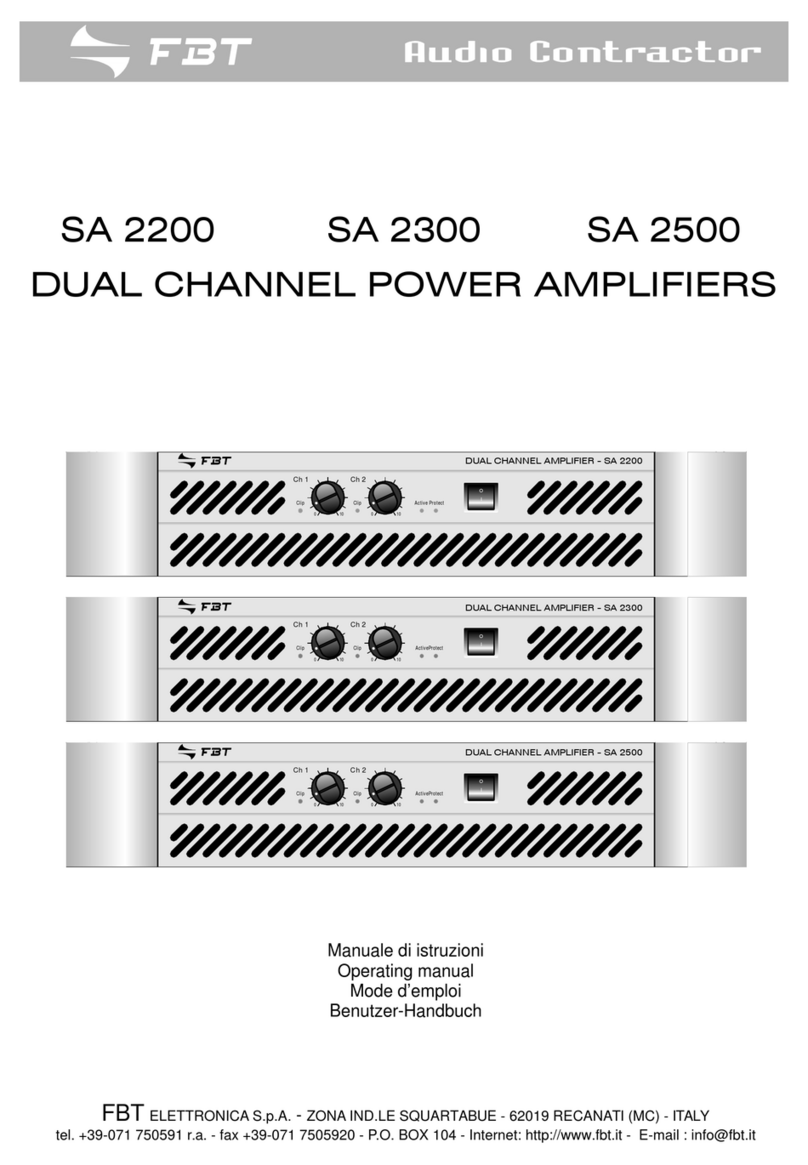
Fbt
Fbt SA 2200 User manual
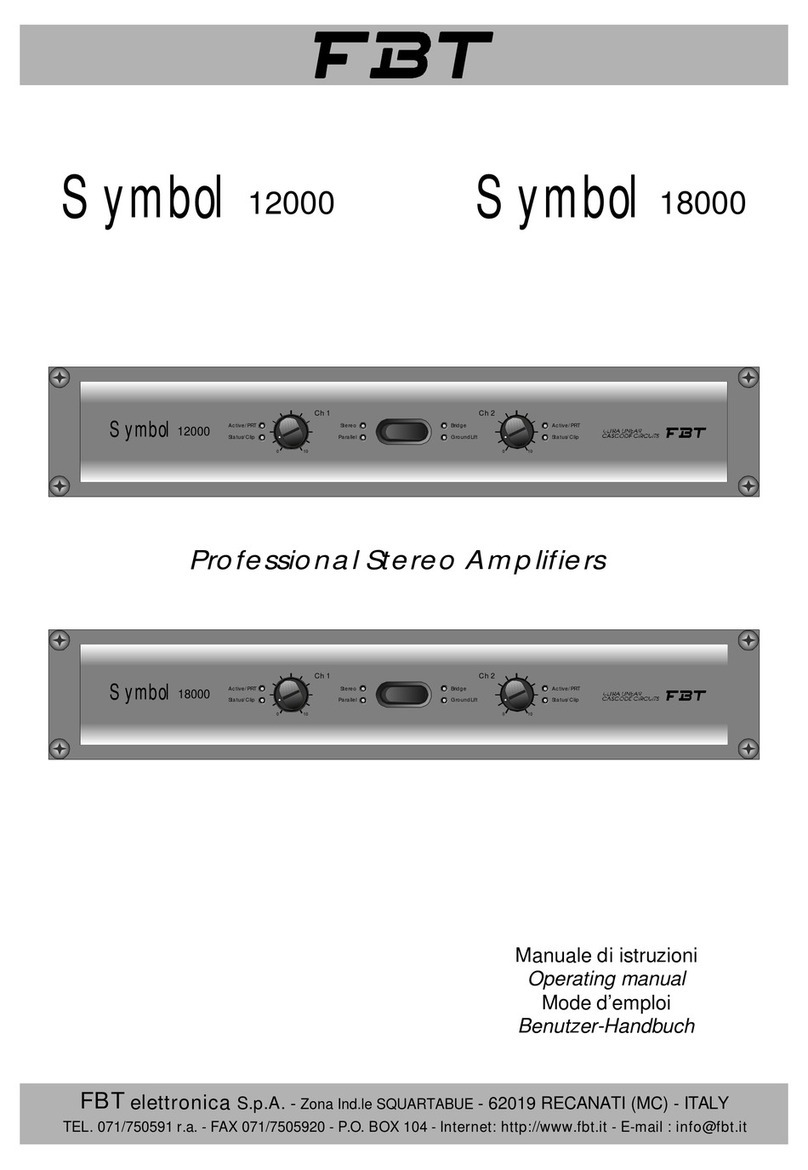
Fbt
Fbt symbol 12000 User manual
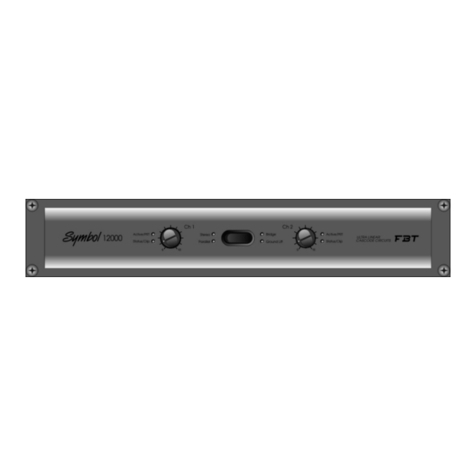
Fbt
Fbt symbol 12000 User manual

Fbt
Fbt Audio Contractor MMZ 8004 S User manual
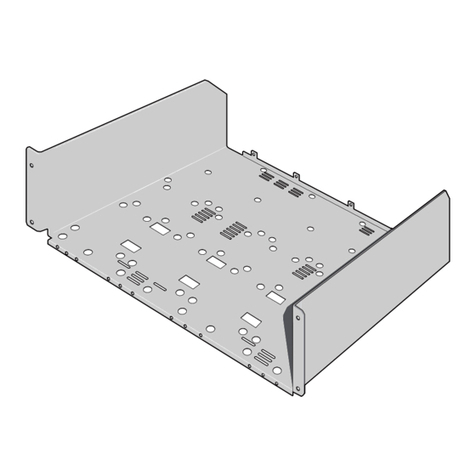
Fbt
Fbt CHA 1004 User manual

Fbt
Fbt Audio Contractor MMA 6120-TCD/MP3 User manual
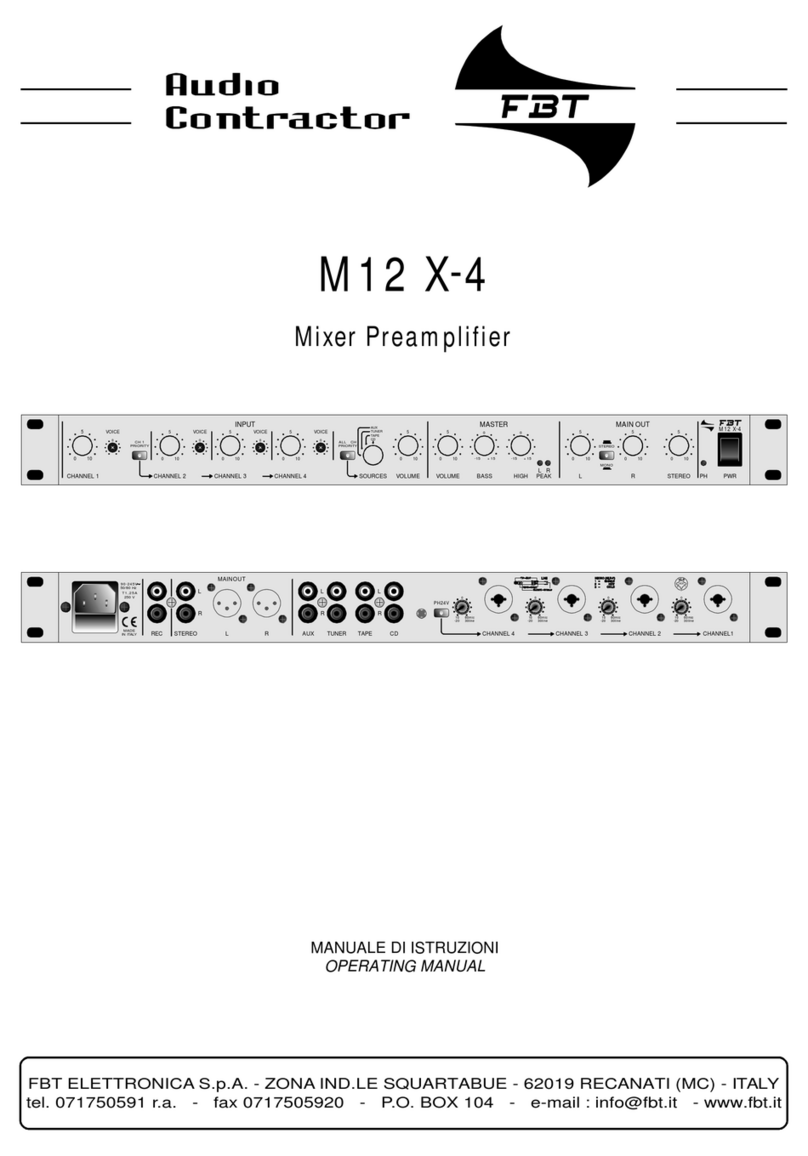
Fbt
Fbt M12 X-4 User manual

Fbt
Fbt MXA 3120 User manual
Popular Amplifier manuals by other brands

Kenwood
Kenwood KAC-PS400M instruction manual
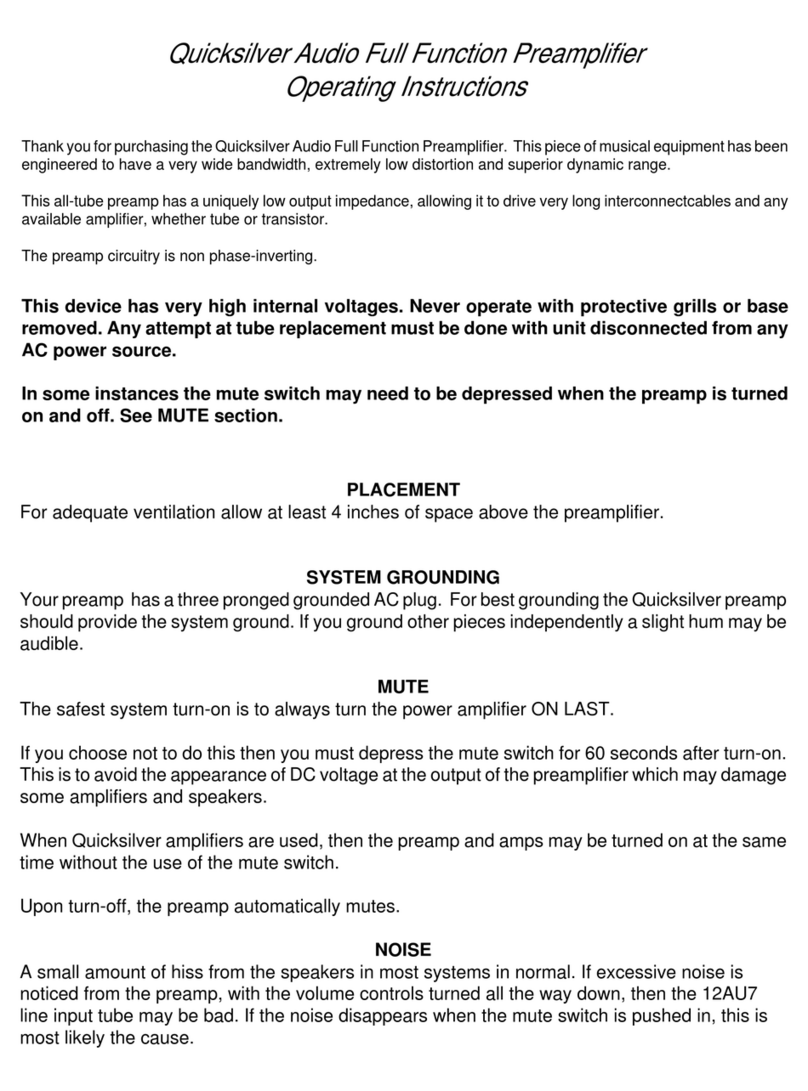
Quicksilver
Quicksilver Preamplifier operating instructions

Crown
Crown CE-1000 Operation manual

Milton Roy
Milton Roy Haskel AA-15 Operating and maintenance instructions

Moonriver Audio
Moonriver Audio 404 operating instructions

Niles
Niles SWA-500M Specification sheet
